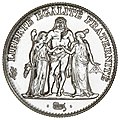|
Greek – Kingdom of
Thrace
–
Lysimachos
– King: 323-281 B.C. –
Bronze 12mm (1.49 grams) Struck in the Kingdom of Thrace circa 297-281 B.C.
Reference: Sear 6822; Muller, pl. II,14; Forrer/Weber 2735
Head of young
Hercules
right, clad in lion’s skin.
BAΣΙ / ΛΥΣ within corn-wreath.
One of the most remarkable of the ‘Successors’ of Alexander, Lysimachos was
of Thessalian stock and was a bodyguard of the great Macedonian King. In the
confused period following Alexander’s death he obtained the government of
Thrace, and in 309 B.C. founded his capital city of Lysimacheia where many of
his coins were struck. In 305 B.C. he took the title of King, and four years
later extended his rule over much of Asia Minor following the defeat of
Antigonos the One-eyed at Ipos. His later years were marred by domestic tragedy
and his harsh rule made him unpopular with his subjects. In 281 B.C. Lysimachos,
now aged 80, was attacked by Seleukos of Syria who was only two years his
junior. Lysimachos died fighting at the battle of Korupedion and his kingdom
disappeared with him. But his memory lived on and generations later a number of
mints in the Black Sea area restored his coin types for their autonomous issues.
You are bidding on the exact item pictured,
provided with a Certificate of Authenticity and Lifetime Guarantee of
Authenticity.
Hercules is the Roman name for the Greek
divine
hero Heracles
, who was the son of
Zeus (Roman equivalent
Jupiter
) and the mortal
Alcmene
. In
classical mythology
, Hercules is famous for his
strength and for his numerous far-ranging adventures.
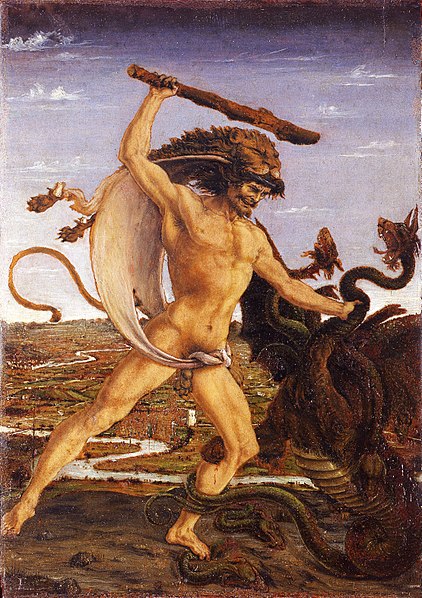
The Romans adapted the Greek hero’s iconography and myths for their
literature and art under the name Hercules. In later
Western art
and literature and in
popular culture
, Hercules is more
commonly used than Heracles as the name of the hero. Hercules was a
multifaceted figure with contradictory characteristics, which enabled later
artists and writers to pick and choose how to represent him. This article
provides an introduction to representations of Hercules in the
later tradition
.
Labours
Hercules is known for his many adventures, which took him to the far reaches
of the
Greco-Roman world
. One cycle of these
adventures became
canonical
as the “Twelve Labours,” but the list
has variations. One traditional order of the labours is found in the
Bibliotheca
as follows:
- Slay the
Nemean Lion
.
- Slay the nine-headed
Lernaean Hydra
.
- Capture the
Golden Hind of Artemis
.
- Capture the
Erymanthian Boar
.
- Clean the Augean
stables in a single day.
- Slay the
Stymphalian Birds
.
- Capture the
Cretan Bull
.
- Steal the
Mares of Diomedes
.
- Obtain the girdle of
Hippolyta
, Queen of the
Amazons
.
- Obtain the cattle of the monster
Geryon
.
- Steal the apples of the
Hesperides
.
- Capture and bring back
Cerberus
.
The Latin
name Hercules was borrowed through
Etruscan
, where it is represented variously as
Heracle
, Hercle, and other forms. Hercules was
a favorite subject for
Etruscan art
, and appears often on
bronze mirrors
. The Etruscan form Herceler
derives from the Greek Heracles via
syncope
. A mild oath invoking Hercules (Hercule!
or Mehercle!) was a common
interjection
in
Classical Latin
.

Baby Hercules strangling a
snake
sent to
kill him in his
cradle
(Roman marble, 2nd century CE)
Hercules had a number of
myths
Cacus, who was terrorizing the countryside of
Rome. The hero was associated with the
Aventine Hill
through his son
Aventinus
.
Mark Antony
considered him a personal patron
god, as did the emperor
Commodus
. Hercules received various forms of
religious veneration
, including as a
deity concerned with children and childbirth
,
in part because of myths about his precocious infancy, and in part because he
fathered countless children. Roman brides wore a special belt tied with the “knot
of Hercules“, which was supposed to be hard to untie.[4]
The comic playwright
Plautus
presents the myth of Hercules’
conception as a sex comedy in his play
Amphitryon
;
Seneca
wrote the tragedy Hercules Furens
about his bout with madness. During the
Roman Imperial era
, Hercules was worshipped
locally from Hispania
through
Gaul.
Medieval mythography
After the Roman Empire became
Christianized
, mythological narratives were
often reinterpreted as
allegory
, influenced by the philosophy of
late antiquity
. In the 4th century,
Servius
had described Hercules’ return from the
underworld as representing his ability to overcome earthly desires and vices, or
the earth itself as a consumer of bodies. In medieval mythography, Hercules was
one of the heroes seen as a strong role model who demonstrated both valor and
wisdom, with the monsters he battles as moral obstacles. One
glossatorr
noted that when
Hercules became a constellation
, he showed that
strength was necessary to gain entrance to Heaven.
Medieval mythography was written almost entirely in Latin, and original Greek
texts were little used as sources for Hercules’ myths.
Renaissance
mythography
The Renaissance
and the invention of the
printing press
brought a renewed interest in
and publication of Greek literature. Renaissance mythography drew more
extensively on the Greek tradition of Heracles, typically under the Romanized
name Hercules, or the alternate name
Alcides
. In a chapter of his book
Mythologiae (1567), the influential mythographer
Natale Conti
collected and summarized an
extensive range of myths concerning the birth, adventures, and death of the hero
under his Roman name Hercules. Conti begins his lengthy chapter on Hercules with
an overview description that continues the moralizing impulse of the Middle
Ages:
Hercules, who subdued and destroyed monsters, bandits, and criminals, was
justly famous and renowned for his great courage. His great and glorious
reputation was worldwide, and so firmly entrenched that he’ll always be
remembered. In fact the ancients honored him with his own temples, altars,
ceremonies, and priests. But it was his wisdom and great soul that earned
those honors; noble blood, physical strength, and political power just
aren’t good enough.
Lysimachus (Greek:
Λυσίμαχος, Lysimachos; 360 BCE – 281 BCE) was a
Macedonian
officer and
diadochus
(i.e. “successor”) of
Alexander the Great
, who became a
basileus
(“king”) in 306 BCE, ruling
Thrace
,
Asia Minor
and
Macedonia
.
//
Early
career
Lysimachus was born in 362/361 BC, the son of the
Thessalian
Agathocles from
Crannon
. He was granted citizenship in
Macedon
and was educated at the court in
Pella
. He was
probably appointed
Somatophylax
during the reign of Philip II.[1]
During Alexander’s
Persian
campaigns, he was one of his immediate bodyguards. In
324 BCE
, in Susa, he was crowned in recognition for his actions in India.[2]
After Alexander’s death in 323 BCE, he was appointed to the government of Thrace
as strategos
.
Diadochi
In 315 BCE, he joined
Cassander
,
Ptolemy
and
Seleucus
against
Antigonus
, who, however, diverted his attention by stirring up Thracian and
Scythian
tribes against him. In 309 BCE, he founded
Lysimachia
in a commanding situation on the neck connecting the Chersonese
with the mainland. He followed the example of Antigonus in taking the title of
king.[4]
In 306 or 305, he assumed the title of “King”, which he held until his death
at Corupedium in 282/1.[5]
In 302, when the second affiance between Cassander, Ptolemy and
Seleucus was made, Lysimachus, reinforced by troops from Cassander, entered Asia
Minor, where he met with little resistance. On the approach of Antigonus he
retired into winter quarters near
Heraclea
, marrying its widowed queen
Amastris
, a
Persian princess. Seleucus joined him in 301 BCE, and at the
battle of Ipsus
Antigonus was defeated and slain. His dominions were divided
among the victors. Lysimachus share was
Lydia
,
Ionia
,
Phrygia
and
the north coast of Asia Minor.[4]
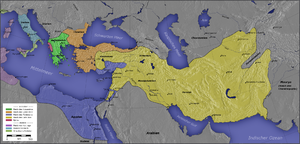
Kingdom of Lysimachus Other
diadochi
Kingdom of
Cassander
Kingdom of
Seleucus_I_Nicator
Kingdom of
Ptolemy
Epirus
Other
Carthage
Rome
Greek
colonies
Feeling that Seleucus was becoming dangerously great, Lysimachus now allied
himself with Ptolemy, marrying his daughter
Arsinoe II of Egypt
. Amastris, who had divorced herself from him, returned
to Heraclea. When Antigonus’s son
Demetrius I of Macedon
renewed hostilities (297 BCE), during his absence in
Greece
,
Lysimachus seized his towns in Asia Minor, but in 294 BCE concluded a peace
whereby Demetrius was recognized as ruler of
Macedonia
. He tried to carry his power beyond the
Danube
, but was
defeated and taken prisoner by the
Getae
king
Dromichaetes
(Dromihete),
who, however, set him free on amicable terms. Demetrius subsequently threatened
Thrace, but had to retire due to a sudden uprising in
Boeotia
, and
an attack from the king
Pyrrhus
of Epirus
.
In 288 BCE, Lysimachus and
Pyrrhus
in turn invaded
Macedonia
, and drove Demetrius out of the country. Lysimachus left
Pyrrhus
in possession of
Macedonia
with the title of king for around seven months before Lysimachus
invaded. For a short while the two ruled jointly but in 285 BCE Lysimachus
expelled Pyrrhus.[6]
Later
years
Domestic troubles embittered the last years of Lysimachus’s life. Amastris
had been murdered by her two sons; Lysimachus treacherously put them to death.
On his return Arsinoe asked the gift of Heraclea, and he granted her request,
though he had promised to free the city. In 284 BCE Arsinoe, desirous of gaining
the succession for her sons in preference to
Agathocles
(the eldest son of Lysimachus), intrigued against him with the
help of her brother
Ptolemy Keraunos
; they accused him of conspiring with Seleucus to seize the
throne, and he was put to death.
This atrocious deed of Lysimachus aroused great indignation. Many of the
cities of Asia revolted, and his most trusted friends deserted him. The widow of
Agathocles fled to Seleucus, who at once invaded the territory of Lysimachus in
Asia. In 281 BCE, Lysimachus crossed the
Hellespont
into Lydia
, and at the decisive
Battle of Corupedium
was killed. After some days his body was found on the
field, protected from birds of prey by his faithful dog.[7]
Lysimachus’s body was given over to his son
Alexander
, by whom it was interred at
Lysymachia
.
Thrace (demonym Thracian
/
ənθreɪʃⁱˈ/;
Bulgarian
:
Тракия, Trakiya,
Greek
: Θράκη,
Thráki,
Turkish
:
Trakya) is a historical and geographic area in southeast
Europe
. As a geographical concept, Thrace
designates a region bounded by the
Balkan Mountains
on the north,
Rhodope Mountains
and the
Aegean Sea
on the south, and by the
Black Sea
and the
Sea of Marmara
on the east. The areas it
comprises are southeastern
Bulgaria
(Northern
Thrace), northeastern
Greece
(Western
Thrace), and the European part of
Turkey
(Eastern
Thrace). The biggest part of Thrace is part of present-day Bulgaria.
In Turkey, it is also called
Rumelia
. The name comes from the
Thracians
, an ancient
Indo-European
people inhabiting Southeastern
Europe.
The historical boundaries of Thrace have varied. Noteworthy is the fact that,
at an early date, the
ancient Greeks
employed the term “Thrace” to
refer to all of the territory which lay north of
Thessaly
inhabited by the
Thracians
,[1]
a region which “had no definite boundaries” and to which other regions (like
Macedonia
and even
Scythia
) were added.[2]
In one ancient Greek source, the very Earth is divided into “Asia, Libya, Europa
and Thracia”.[2]
As the knowledge of world geography of the Greeks broadened, the term came to be
more restricted in its application: Thrace designated the lands bordered by the
Danube
on the north, by the Euxine Sea (Black
Sea) on the east, by northern
Macedonia
in the south and by the
Illyrian
lands (i.e.
Illyria
) to the west.[2]
This largely coincided with the Thracian
Odrysian kingdom
, whose borders varied in time.
During this time, specifically after the Macedonian conquest, the region’s old
border with Macedonia was shifted from the
Struma River
to the
Mesta River
.[3][4]
This usage lasted until the Roman conquest. Henceforth, (classical) Thrace
referred only to the tract of land largely covering the same extent of space as
the modern geographical region. In its early period, the
Roman province of Thrace
was of this extent,
but after the administrative reforms of the late 3rd century, Thracia’s much
reduced territory became the six small provinces which constituted the
Diocese of Thrace
. The medieval
Byzantine
theme
of
Thrace
contained only what today is
Eastern Thrace
.
The largest cities of Thrace are:
İstanbul
(European side),
Plovdiv
,
Burgas
,
Stara Zagora
,
Haskovo
,
Edirne
,
Çorlu
and
Tekirdag
.
Most of the Bulgarian and Greek population are Christians, while most of the
Turkish inhabitants of Thrace are Muslims.
Thrace in
ancient Greek mythology
Ancient Greek mythology
provides them with a
mythical ancestor, named
Thrax
, son of the war-god
Ares, who was said to reside in Thrace. The Thracians appear in
Homer
‘s
Iliad
as
Trojan allies, led by
Acamas
and
Peiros
. Later in the Iliad,
Rhesus
, another Thracian king, makes an
appearance. Cisseus
, father-in-law to the Trojan elder
Antenor
, is also given as a Thracian king.
Homeric Thrace was vaguely defined, and stretched from the River
Axios
in the west to the
Hellespont
and
Black Sea
in the east. The
Catalogue of Ships
mentions three separate
contingents from Thrace: Thracians led by Acamas and Peiros, from
Aenus
;
Cicones
led by
Euphemus
, from southern Thrace, near
Ismaros
; and from the city of
Sestus
, on the Thracian (northern) side of the
Hellespont, which formed part of the contingent led by
Asius
. Greek mythology is replete with Thracian
kings, including
Diomedes
,
Tereus
,
Lycurgus
,
Phineus
,
Tegyrius
,
Eumolpus
,
Polymnestor
,
Poltys
, and
Oeagrus
(father of
Orpheus
). In addition to the tribe that Homer
calls Thracians, ancient Thrace was home to numerous other tribes, such as the
Edones
,
Bisaltae
,
Cicones
, and
Bistones
.
Thrace is also mentioned in Ovid’s Metamorphoses in the episode of
Philomela
, Procne, and
Tereus
. Tereus, the King of Thrace, lusts after
his sister-in-law, Philomela. He kidnaps her, holds her captive, rapes her, and
cuts out her tongue. Philomela manages to get free, however. She and her sister,
Procne, plot to get revenge, by killing Itys (son of Tereus and Procne) and
serving him to his father for dinner. At the end of the myth, all three turn
into birds—Procne, a swallow; Philomela, a nightingale; and Tereus, a
hoopoe
.
History
Ancient history
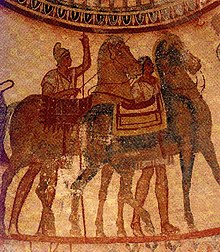
Thracian Tomb of Kazanlak
The indigenous population of Thrace was a people called the
Thracians
, divided into numerous tribal groups.
Thracian troops were known to accompany neighboring ruler
Alexander the Great
when he crossed the
Hellespont
which abuts Thrace, and took on the
Persian Empire
of the day.
The Thracians did not describe themselves as such and Thrace and
Thracians are simply the names given them by the Greeks.[5]
Divided into separate tribes, the Thracians did not manage to form a lasting
political organization until the
Odrysian state
was founded in the 4th century
BC. Like Illyrians
, Thracian tribes of the mountainous
regions fostered a locally ruled warrior tradition, while the tribes based in
the plains were purportedly more peaceable. Recently discovered funeral mounds
in Bulgaria suggest that Thracian kings did rule regions of Thrace with distinct
Thracian national identity.
During this period, a subculture of
celibate
ascetics
called the
Ctistae
lived in Thrace, where they served as
philosophers, priests and prophets.
Medieval history
By the mid 5th century, as the Roman Empire began to crumble, Thracia fell
from the authority of Rome and into the hands of Germanic tribal rulers. With
the fall of Rome, Thracia turned into a battleground territory for the better
part of the next 1,000 years. The eastern successor of the
Roman Empire
in the Balkans, the
Byzantine Empire
, retained control over Thrace
until the 8th century when the northern half of the entire region was
incorporated into the
First Bulgarian Empire
. Byzantium regained
Thrace in the late 10th century and administered it as a
theme
, until the Bulgarians regained
control of the northern half at the end of the 12th century. Throughout the 13th
century and the first half of the 14th century, the region was changing in the
hands of the Bulgarian and the Byzantine Empire(excl. Constantinopole). In 1265
the area suffered a Mongol raid from the
Golden Horde
, led by
Nogai Khan
. In 1352, the
Ottoman
Turks
conducted their first incursion into the
region subduing it completely within a matter of two decades and occupying it
for five centuries.
Modern history
With the
Congress of Berlin
in 1878, Northern Thrace was
incorporated into the semi-autonomous Ottoman province of
Eastern Rumelia
, which united with Bulgaria in
1885. The rest of Thrace was divided among Bulgaria, Greece and Turkey at the
beginning of the 20th century, following the
Balkan Wars
,
World War I
and the
Greco-Turkish War
. Today Thracian is a
strong regional identity in Greece, Turkey, Bulgaria and other neighbouring
countries.
Famous Thracians and people from Thrace
- A number of
Roman emperors
of the 3rd-5th century were
of Thraco-Roman
backgrounds (Maximinus
Thrax,
Licinius
,
Galerius
,
Aureolus
,
Leo the Thracian
, etc.). These emperors
were elevated via a military career, from the condition of common soldiers
in one of the
Roman legions
to the foremost positions of
political power
.
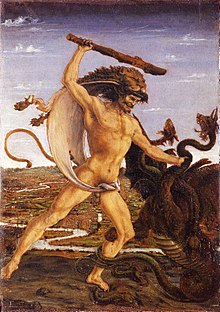
Hercules and the Hydra (ca.
1475) byAntonio
del Pollaiuolo the
hero wears his characteristic lionskin and wields a club
Hercules is the Roman name for
the Greek divine hero Heracles,
who was the son of Zeus (Roman
equivalent Jupiter)
and the mortal Alcmene.
In classical
mythology, Hercules is famous for his strength and for his numerous
far-ranging adventures.
The Romans adapted the Greek hero’s iconography and myths for their literature
and art under the name Hercules.
In later Western
art and literature and in popular
culture, Hercules is
more commonly used than Heracles as
the name of the hero. Hercules was a multifaceted figure with contradictory
characteristics, which enabled later artists and writers to pick and choose how
to represent him. This article
provides an introduction to representations of Hercules in the later
tradition.
Labours

Hercules capturing theErymanthian
Boar, by J.M.
Félix Magdalena (b.
1941)
Main article: Labours
of Hercules
Hercules is known for his many adventures, which took him to the far reaches of
the Greco-Roman
world. One cycle of these adventures became canonical as
the “Twelve Labours,” but the list has variations. One traditional order of the
labours is found in theBibliotheca as
follows:
- Slay the Nemean
Lion.
- Slay the nine-headed Lernaean
Hydra.
- Capture the Golden
Hind of Artemis.
- Capture the Erymanthian
Boar.
- Clean the Augean stables
in a single day.
- Slay the Stymphalian
Birds.
- Capture the Cretan
Bull.
- Steal the Mares
of Diomedes.
- Obtain the girdle of Hippolyta,
Queen of the Amazons.
- Obtain the cattle of the monster Geryon.
- Steal the apples of the Hesperides.
- Capture and bring back Cerberus.
Side adventures
Hercules had a greater number of “deeds
on the side” (parerga) that
have been popular subjects for art, including:
-
Killing a
fire-breathingCacus (Sebald
Beham, 1545)
-
Holding up
the world forAtlas (based
on Heinrich
Aldegrever, 1550)
-
Wrestling
with Achelous(16th-century
plaque)
-
Fighting the
giant Antaeus(Auguste
Couder, 1819)
-
Retrieving Alcestis from
the underworld (Paul
Cézanne, 1867)
-
Freeing Prometheus(Christian
Griepenkerl, 1878)
Roman era
Main article: Hercules
in ancient Rome
The Latin name Hercules was
borrowed through Etruscan,
where it is represented variously as Heracle,
Hercle, and other forms. Hercules was a favorite subject for Etruscan
art, and appears often on bronze
mirrors. The Etruscan form Herceler derives
from the Greek Heracles via syncope.
A mild oath invoking Hercules (Hercule! or Mehercle!)
was a common interjection in Classical
Latin.

Baby Hercules strangling asnake sent
to kill him in his cradle(Roman
marble, 2nd century CE)
Hercules had a number of myths that
were distinctly Roman. One of these is Hercules’ defeat of Cacus,
who was terrorizing the countryside of Rome. The hero was associated with the Aventine
Hill through his son Aventinus. Mark
Antony considered him a personal
patron god, as did the emperor Commodus.
Hercules received various forms of religious
veneration, including as a deity
concerned with children and childbirth, in part because of myths about his
precocious infancy, and in part because he fathered countless children. Roman
brides wore a special belt tied with the “knot
of Hercules”, which was supposed to be hard to untie. The
comic playwright Plautus presents
the myth of Hercules’ conception as a sex comedy in his play Amphitryon; Senecawrote
the tragedy Hercules Furens about
his bout with madness. During the Roman
Imperial era, Hercules was worshipped locally from Hispania through Gaul.
Germanic association
Tacitus records a special
affinity of the Germanic
peoples for Hercules. In chapter
3 of his Germania,
Tacitus states:
… they say that
Hercules, too, once visited them; and when going into battle, they sang of
him first of all heroes. They have also those songs of theirs, by the
recital of this barditus as
they call it, they rouse their courage, while from the note they augur the
result of the approaching conflict. For, as their line shouts, they inspire
or feel alarm.
In the Roman era Hercules’
Club amulets appear from the 2nd
to 3rd century, distributed over the empire (including Roman
Britain, c.f. Cool 1986), mostly made of gold, shaped like wooden clubs. A
specimen found in Köln-Nippes bears
the inscription “DEO HER[culi]”,
confirming the association with Hercules.
In the 5th to 7th centuries, during the Migration
Period, the amulet is theorized to have rapidly spread from the Elbe
Germanic area across Europe.
These Germanic “Donar’s
Clubs” were made from deer antler, bone or wood, more rarely also from bronze or
precious metals.They are found exclusively in female graves, apparently worn
either as a belt pendant, or as an ear pendant. The amulet type is replaced by
the Viking
Age Thor’s
hammer pendants in the course of
the Christianization
of Scandinavia from the 8th to
9th century.
Medieval mythography

Hercules and the Nemean
lionin the 15th-century Histoires
de Troyes
After the Roman Empire became Christianized,
mythological narratives were often reinterpreted as allegory,
influenced by the philosophy of late
antiquity. In the 4th century, Servius had
described Hercules’ return from the underworld as representing his ability to
overcome earthly desires and vices, or the earth itself as a consumer of bodies. In
medieval mythography, Hercules was one of the heroes seen as a strong role model
who demonstrated both valor and wisdom, with the monsters he battles as moral
obstacles. One glossator noted
that when Hercules
became a constellation, he showed that strength was necessary to gain
entrance to Heaven.
Medieval mythography was written almost entirely in Latin, and original Greek
texts were little used as sources for Hercules’ myths.
Renaissance mythography
The Renaissance and
the invention of the printing
press brought a renewed interest
in and publication of Greek literature. Renaissance mythography drew more
extensively on the Greek tradition of Heracles, typically under the Romanized
name Hercules, or the alternate name Alcides.
In a chapter of his book Mythologiae (1567),
the influential mythographer Natale
Conti collected and summarized an
extensive range of myths concerning the birth, adventures, and death of the hero
under his Roman name Hercules. Conti begins his lengthy chapter on Hercules with
an overview description that continues the moralizing impulse of the Middle
Ages:
Hercules, who
subdued and destroyed monsters, bandits, and criminals, was justly famous
and renowned for his great courage. His great and glorious reputation was
worldwide, and so firmly entrenched that he’ll always be remembered. In fact
the ancients honored him with his own temples, altars, ceremonies, and
priests. But it was his wisdom and great soul that earned those honors;
noble blood, physical strength, and political power just aren’t good enough.
In art
In Roman works of art and in Renaissance and post-Renaissance art, Hercules can
be identified by his attributes, the lion
skin and the gnarled club (his
favorite weapon); in mosaic he
is shown tanned bronze, a virile aspect.
Roman era
-
Hercules of the Forum Boarium (Hellenistic,
2nd century BCE)
-
Hercules and Iolaus (1st
century CE mosaic from the Anzio Nymphaeum, Rome)
-
Hercules (Hatra,
Iraq,Parthian
period, 1st-2nd century CE)
-
Hercules
bronze statuette, 2nd century CE (museum of Alanya, Turkey)
-
Hercules and
the Nemean
Lion (detail), silver plate,
6th century (Cabinet
des Médailles, Paris)
Modern era
-
The Giant
Hercules (1589) by Hendrik
Goltzius
-
The
Drunken Hercules(1612-1614) by Rubens
-
Hercules in
the Augean
stable (1842, Honoré
Daumier)
-
Comic book cover
(c.1958)
-
Hercules, Deianira and
the Centaur Nessus, byBartholomäus
Spranger, 1580 – 1582
-
Henry IV of France, as Hercules vanquishing theLernaean
Hydra (i.e. theCatholic
League), byToussaint
Dubreuil, circa 1600. Louvre
Museum
In numismatics
Hercules was among the earliest figures on ancient Roman coinage, and has been
the main motif of many collector coins and medals since. One example is the 20
euro Baroque Silver coin issued
on September 11, 2002. The obverse side of the coin shows the Grand Staircase in
the town palace of Prince
Eugene of Savoy in Vienna,
currently the Austrian Ministry of Finance. Gods and demi-gods hold
its flights, while Hercules stands at the turn of the stairs.
-
Juno, with Hercules fighting a Centaur on
reverse (Roman, 215–15 BCE)
-
Club over
his shoulder on a Roman denarius (ca.
100 BCE)
-
Maximinus II and
Hercules with club and lionskin (Roman, 313 CE)
-
Commemorative 5-francpiece
(1996), Hercules in center
Other cultural
references
-
Pillars of Hercules, representing the Strait
of Gibraltar (19th-century
conjecture of the Tabula
Peutingeriana)
-
The Cudgel of Hercules, a tall limestone rock
formation, with Pieskowa
Skała Castle in the
background
-
Hercules as heraldic
supporters in the royal
arms of Greece,
in use 1863–1973. The phrase “Ηρακλείς του στέμματος” (“Defenders of
the Crown”) has pejorative connotations (“chief henchmen”) in Greek.
In films
For a list of films featuring Hercules, see Hercules
in popular culture#Filmography.
A series of nineteen Italian Hercules movies were made in the late 1950s and
early 1960s. The actors who played Hercules in these films were Steve
Reeves, Gordon
Scott, Kirk Morris, Mickey
Hargitay, Mark Forest, Alan Steel, Dan
Vadis, Brad
Harris, Reg
Park, Peter
Lupus (billed as Rock
Stevens) and Michael Lane. A number of English-dubbed Italian films that
featured the name of Hercules in their title were not intended to be movies
about Hercules.
|
































